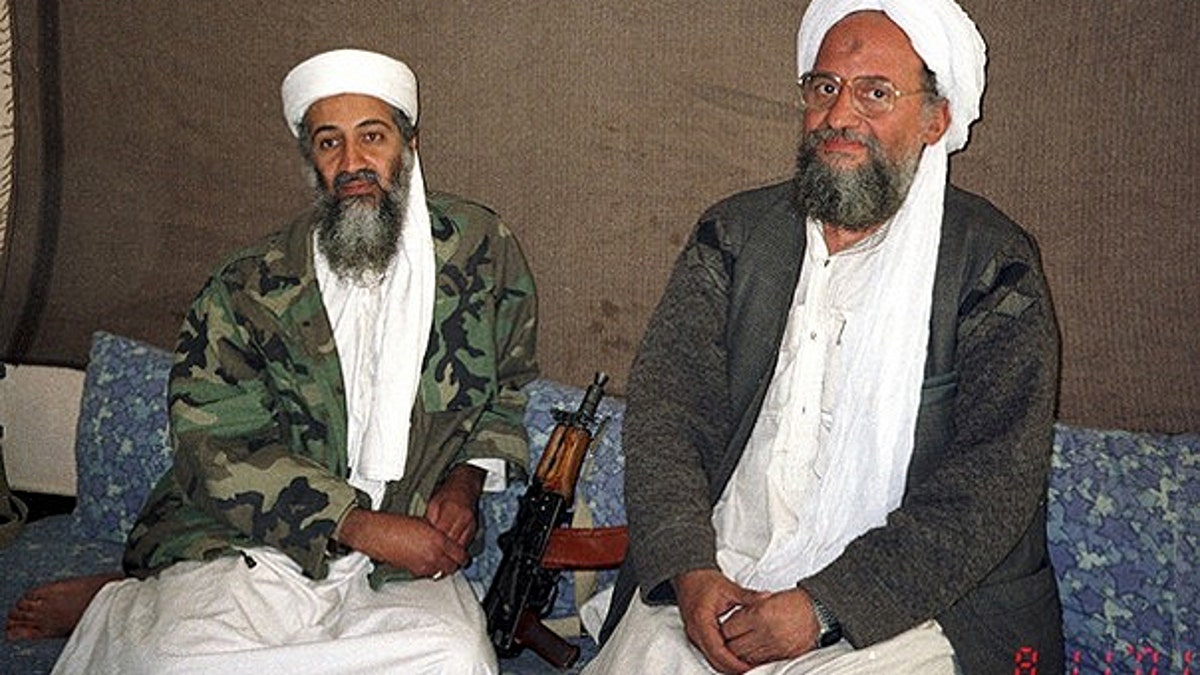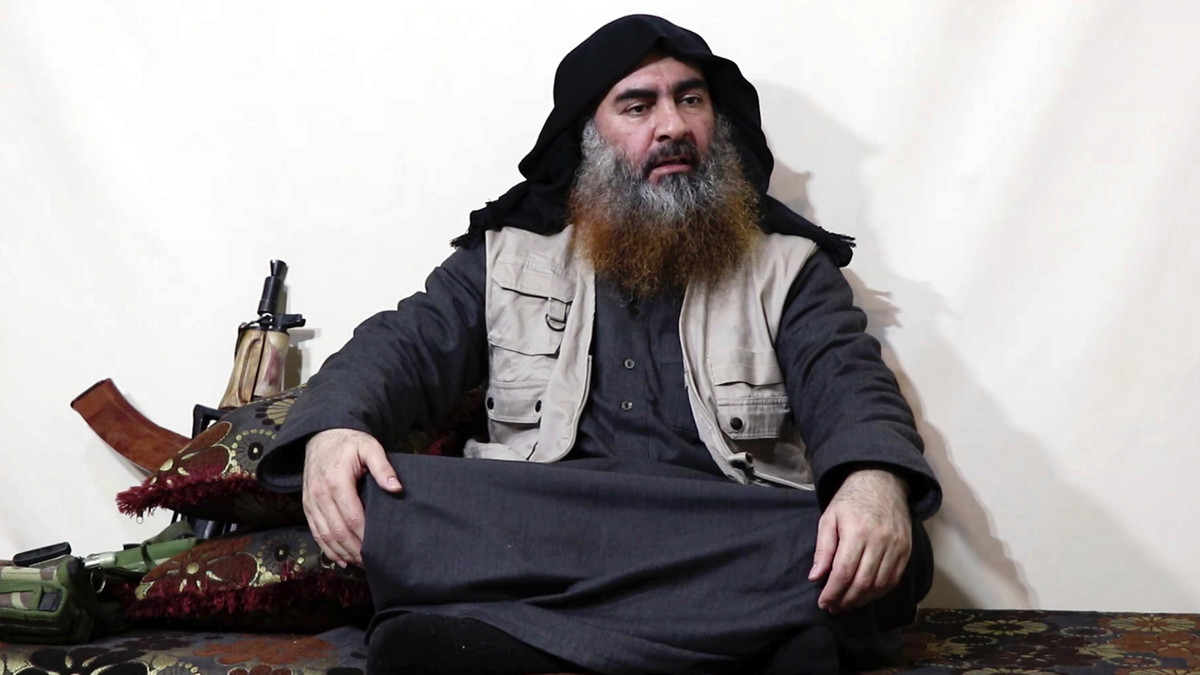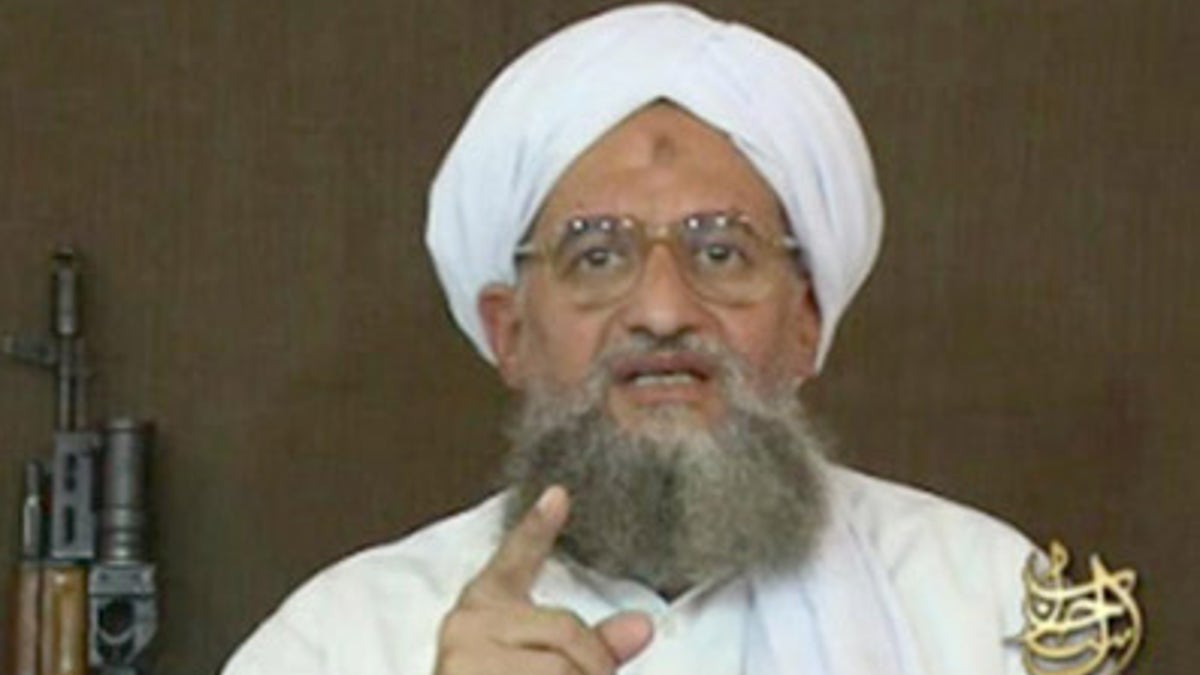
Nov. 10, 2001: Usama bin Laden sits with his adviser and purported successor Ayman al-Zawahiri, an Egyptian linked to the Al Qaeda network, during an interview with Pakistani journalist Hamid Mir (not pictured) in an image supplied by the respected Dawn newspaper. (Reuters)
Nestled alongside ISIS leader Abu Bakr Al Baghdadi in the deepest ranks of the depraved, Al Qaeda’s chief Ayman Al Zawahiri is one of the two most wanted men in the world – both have a $25 million U.S. bounty on their heads.
But while much has been speculated about when it comes to the barbaric Iraqi man Al Baghdadi, little is known about the Al Qaeda commander who has evaded his big bounty since it was installed immediately following the September 11 attacks.
“Zawahiri was a conspirator of the 9/11 attacks, and like other conspirators, will always be wanted by the United States,” said Rita Katz, Executive Director of the SITE Intelligence Group. “Zawahiri has framed himself more as the wiser alternative to Baghdadi and ISIS, who he characterizes as naïve and irresponsible.”
So who exactly is the elusive Zawahiri?
Egyptian-born Zawahiri, 67, took the reins as Al Qaeda’s ruler after the Navy SEAL raid that killed the group’s long-running mastermind, Usama bin Laden eight years ago. He also comes with a long list of pseudonyms ranging from Abu Mohammed, The Doctor, The Teacher and Abdul Qader Abdul Aziz Abdul Moez Al Doctor to Abu Fatma, Abdel Muaz, Nur, Ustaz and Dhawahri Ayman.
The greying, white-turban wearing eye surgeon got his start as a teenage member of Cairo’s Muslim Brotherhood, where he formed his own underground cell devoted to establishing an “Islamist State” called Egyptian Islamic Jihad before going on to medical school.
Zawahiri went on to climb the terrorist ranks in his early 30s after a religious visit to Saudi Arabia in 1985, in which he soon merged his outfit with Usama bin Laden’s fighting fleet and became his personal physician and adviser around 1986. In 1993, he is reported to have even traveled to California to raise money for Afghan children wounded in the war with the Soviets.
In the ensuing years, Zawahiri ordered such attacks as the 1995 bombing of the Egyptian embassy in Islamabad, Pakistan and played a prominent part in the coordinated series of 1998 U.S. embassy explosions in East Africa.

This file image made from video posted on a militant website Monday, April 29, 2019, purports to show the leader of the Islamic State group, Abu Bakr al-Baghdadi, being interviewed by his group's Al-Furqan media outlet. No longer burdened by territory and administration, Islamic State group leader Abu Bakr al-Baghdadi outlined the new path forward for his group: Widen your reach, connect with far-flung militant groups and exhaust your enemies with a “war of attrition.” (Al-Furqan media via AP, File)
Zawahiri’s first wife and two of his six children were reported to have died in a U.S airstrike in Afghanistan in late 2001.
After the stunning ISIS rise some five years ago following a split from Al Qaeda, Zawahiri came out to denounce the rival organization’s savagery – a strategic bid not to alienate vast segments of the population opposed to the ISIS mentality.
While Baghdadi is seemingly camera shy, having surfaced in a video recording last month for just the second time since declaring himself the “caliph” in 2014, Zawahiri is frequently featured on the propaganda small screen – flouting the many forces trying unsuccessfully to track him down.
On Friday, Al Qaeda – through its media branch Al-Sahab – released a video with audio footage of Al-Zawahiri paying tribute to prominent jihadist Jalaluddin Haqqani, who died of “poor health” last September. Five days earlier, on May 5, Al-Sahab’s Telegram channel released a rambling 44-minute long Zawahiri message stressing unity among Muslims and reminiscing about the bin Laden era.
A month earlier on April 5, Al Qaeda unveiled its new Arabic-language magazine One Ummah on Telegram and cautioned the “mujahedeen” to ward off internal bickering, vowing that Al Qaeda would “correct” some mistakes made in the past and was entering a “new phase” to regain trust. In February, Zawahiri’s video starred him delivering a long-winded spiel about the failure of the 2011 Arab uprisings to achieve their goals and depicting the U.S., Israel, Russia, France, China, and the Hindus as their direst of enemies.
In 2014, he called for the bounce back of Al Qaeda in India.
So where the heck is he hiding out?
The intelligence on his present location remains varied. In early 2017, according to U.S. sources, attention was put on Pakistan as the likely sanctuary.
Most recently, intelligence operatives both based in the United States and the Middle East have pinpointed his locale to the ungoverned tribal areas of Afghanistan, neighboring Pakistan. However, one high-ranking source also told Fox News that Syria is also being combed as a high possibility.

A video still of Ayman al-Zawahiri, the current leader of Al Qaeda. (AP/IntelCenter)
“By most accounts he is in the Waziristan region,” said Steven Stalinsky, Executive Director of the Middle East Media Research Institute (MEMRI) and author of “American Traitor,” documenting the life of an American close to the elusive Zawahiri, referring to the unruly mountainous terrain on the Pakistan side of the Afghan border. “There have been numerous reports of sightings, and even of his capture, but these are generally considered to be false alarms.”
THE MASTER BEHIND THE MASK: WHO IS IRAN’S MOST FEARED AND POWERFUL MILITARY COMMANDER?
In recent times, Stalinsky observed, there has been next to no “jihadi chatter” concerning his coordinates or the $25 million reward.
“He is number one on the Tier one hit list,” noted the insider. “As you know, it has been proven that you can lay low in war zones. But he is definitely being hunted.”
In early 2016, the U.S. conducted a drone strike on Zawahiri’s confirmed location in North Waziristan’s Shawal Valley in Pakistan, Newsweek reported, but he managed to escape. A decade earlier, the U.S was reported to have launched an airstrike on the Pakistani border village of Damadola, near Afghanistan – acting on intelligence Zawahiri was bunkered down there, but he was not among those killed. A year earlier, the NSA intercepted Al Qaeda communications bound for him from a location in Baghdad to his dwellings traced to Pakistan.
In 2008, Pakistani officials said they raided an area in the country’s northwest, but the capture attempt came up empty-handed.
Even though the world’s eyes have been fixed on the rise and fall of ISIS as the world’s most dangerous terrorist outfit, experts and analysts caution that Al Qaeda has been quietly curating a revived global game plan that will likely prove far more resilient and lethal.
“Al Qaeda is better known for the long game, waiting out time and seemingly just looking on as ISIS rises and ultimately falls. So for the intelligence community, silence isn’t a sign of terror receding. It is almost as if it is Al Qaeda’s game plan,” said Raphael Gluck, founding partner of monitoring site Jihadoscope.

Border between Pakistan and Afghanistan along a stretch of the Federally Administered Tribal Areas (FATA) (Fox News/Hollie McKay)
Its branches now range from the Islamic Maghreb (AQIM), the Arabian Peninsula (AQAP), Indian Subcontinent (AQIS) and Egypt to Al-Shabaab in Somalia, Jama’at Nusrat al-Islam wal-Muslimin (JNIM) in Mali and West Africa, and Hayat Tahir al-Sham (HTS) in Syria. While the latter claimed in August 2016 to have cut ties with the extremist outfit, the U.S. State Department deems it all much of the same.
The number of fighters loyal to Al Qaeda is believed to stand at at least 40,000. Last year, Al Qaeda executed more than 315 attacks worldwide, according to The Armed Conflict Location & Data Project (ACLED).
But over the past few years, the aging Zawahiri has been slowly passing the baton to the younger and likely savvier recruiter Hamza bin Laden, the about 30-year-old son of the dead terror honcho. Last week, the FBI’s Justice for Rewards listed him as a wanted man with a $1 million premium of his own attached.
“Zawahiri’s role is being eclipsed by the rise of Osama bin Laden's son Hamza, who is expected to take over the position of his late father,” added Lina Khatib, head of the Middle East and North Africa Program at Chatham House. “Al Qaeda is getting a new lifeline with the decline of ISIS and will use the military defeat of ISIS to present itself to supporters as the more successful model of Salafi jihadism. It is likely to expand its operations against Western targets to prove that it is influential, but without resorting to the same opportunistic tactics of ISIS.”




















